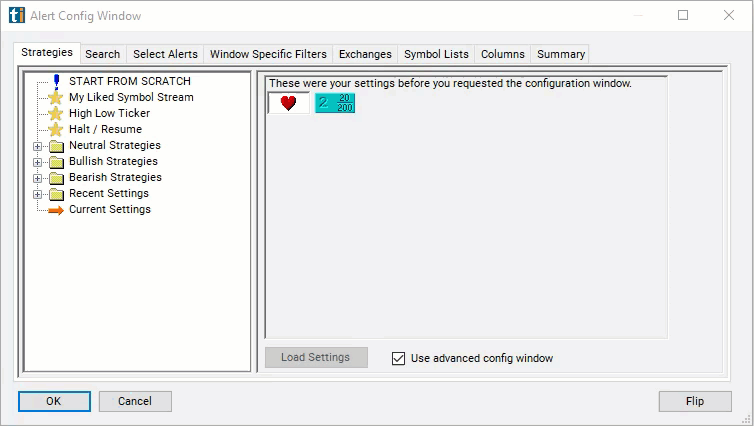20 Vs. 200 Period SMA (5m)
Table of Contents
- Understanding the 20 Vs. 200 Period SMA 5 Minute Filter
- 20 Vs. 200 Period SMA 5 Minute Filter Settings
- Using the 20 Vs. 200 Period SMA 5 Minute Filter
- FAQs
Understanding the 20 Vs. 200 Period SMA 5 Minute Filter
The "20 Vs. 200 Period SMA (5m)" filter in stock trading compares two different Simple Moving Averages (SMA) calculated on a 5-minute chart. SMAs are popular technical indicators used by traders to assess the direction and strength of a stock's price trend.
Here's how this filter works:
Simple Moving Average (SMA): The SMA is calculated by averaging the closing prices of a stock over a specified period. In this filter, two SMAs are employed: a 20-period SMA and a 200-period SMA.
Comparison: The 20-period SMA represents the short-term trend, considering a shorter time frame of price data. Conversely, the 200-period SMA represents the long-term trend, considering a longer time frame of price data. By comparing these two SMAs, traders gain insights into the relationship between short-term and long-term trends in the stock's price movement. The number is always expressed as a percentage.
Signal Generation: When the 20-period SMA crosses above the 200-period SMA, it may indicate a bullish signal, suggesting that short-term momentum is increasing relative to long-term momentum. This is often referred to as a "golden cross" and is considered a bullish indicator. Conversely, when the 20-period SMA crosses below the 200-period SMA, it may indicate a bearish signal, suggesting that short-term momentum is decreasing relative to long-term momentum. This is known as a "death cross" and is considered a bearish indicator.
Interpretation: Traders can use these crossover signals to make trading decisions. For example, a bullish crossover may signal a potential entry point for long positions, while a bearish crossover may signal a potential entry point for short positions. Additionally, the relative positioning of the two SMAs can provide insights into the strength and duration of the prevailing trend.
Chart Representation: On a 5-minute chart, each candlestick represents price action that occurred over a 5-minute period. The SMAs are plotted on the chart, allowing traders to visually identify crossovers and trend dynamics.

20 Vs. 200 Period SMA 5 Minute Filter Settings
Configuring the "20 Vs. 200 Period SMA 5 Minute Filter" is simple and can be done within the Window Specific Filters Tab of the Configuration Window in your Alert/Top List Window.
Here's how to set up the filter in your configuration window:
-
Adjust the minimum value to 1 to to see only stocks in which the 20-period SMA is above the 200 Period SMA on a 5 minute chart.
-
Set the maximum value to -1 to focus only on stocks in which the 20-period SMA is below the the 200 Period SMA on a 5 minute chart.

Using the 20 Vs. 200 Period SMA 5 Minute Filter
The "20 Vs. 200 Period SMA 5 Minute" filter can be used in various trading strategies, including:
Crossover Strategy: Traders often utilize crossover signals between the 20-period SMA and the 200-period SMA to identify potential entry and exit points. They may buy when the 20-period SMA crosses above the 200-period SMA (golden cross) and sell when the 20-period SMA crosses below the 200-period SMA (death cross).
Pullback Strategy: After a bullish crossover (20-period SMA crossing above the 200-period SMA), traders may wait for a pullback in the price to retest the crossover point. If the price holds above the crossover point during the pullback, it may serve as a confirmation of the bullish trend, providing an opportunity to enter long positions. Similarly, after a bearish crossover (20-period SMA crossing below the 200-period SMA), traders may wait for a pullback in the price to retest the crossover point. If the price holds below the crossover point during the pullback, it may confirm the bearish trend, offering an opportunity to enter short positions.
Confirmation Strategy: Traders can use the relative positioning of the 20-period SMA and the 200-period SMA to confirm trend direction. For example, if the 20-period SMA is above the 200-period SMA and both SMAs are sloping upward, it confirms an uptrend. Conversely, if the 20-period SMA is below the 200-period SMA and both SMAs are sloping downward, it confirms a downtrend. Traders may enter positions in alignment with the confirmed trend direction.
FAQs
How do I interpret a crossover between the 20-period SMA and the 200-period SMA?
- A crossover occurs when the 20-period SMA crosses above or below the 200-period SMA. A bullish crossover, known as a "golden cross," happens when the 20-period SMA crosses above the 200-period SMA, indicating potential bullish momentum. Conversely, a bearish crossover, known as a "death cross," occurs when the 20-period SMA crosses below the 200-period SMA, signaling potential bearish momentum.
Is the "20 Vs. 200 Period SMA (5m)" filter suitable for all trading styles?
- This filter is commonly used by traders who focus on medium to long-term trends. It may not be as relevant for traders employing very short-term intraday strategies.
How often do crossovers occur between the 20-period SMA and the 200-period SMA?
- The frequency of crossovers depends on market conditions and the volatility of the stock or asset being analyzed. In volatile markets, crossovers may occur more frequently, while in stable markets, they may occur less often.
Should I use additional indicators in conjunction with the 20 Vs. 200 Period SMA (5m) filter?
- While the 20 Vs. 200 Period SMA (5m) filter can provide valuable insights into trend direction, it's often beneficial to use additional technical indicators or fundamental analysis to confirm trading signals and make well-informed decisions.
Filter Info for 20 Vs. 200 Period SMA (5m) [5Sma20a200]
- description = 20 vs. 200 Period SMA (5m)
- keywords = Fixed Time Frame Moving Average
- units = %
- format = 1
- toplistable = 1
- parent_code = 2Sma20a200




